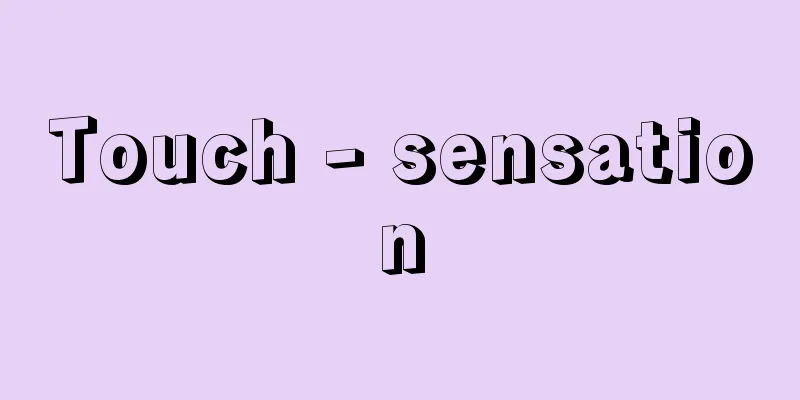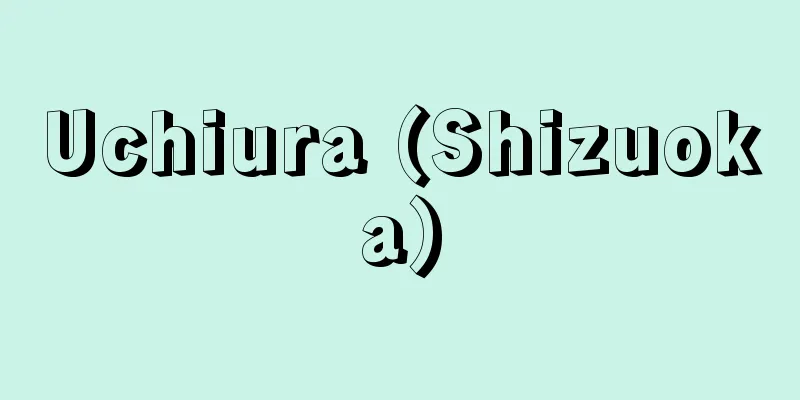Touch - sensation

|
A sensation caused by tactile stimulation applied to the surface of a living body (skin or mucous membrane). It is one of the so-called "movement receptor senses" that are on the same level as pressure and vibratory sensations. Touch occurs when tactile stimulation, a type of mechanical stimulation, causes movement of biological tissues such as hair movement or deformation or distortion of the skin or mucous membranes. Peripheral sensory units that receive mechanical stimulation (areas that become excited in response to a certain stimulation) are divided into three types based on whether they adapt quickly or slowly. In other words, vibratory sensation is the quickest adapting sensation, pressure sensation is the slowest adapting sensation, and touch is intermediate. However, the boundary between these speeds is not necessarily strict. The places where we sense touch are called tactile points, and are distributed in dots on the surface of the body. Touch receptors are nerve endings of various shapes, and their distribution density is highest on the skin of the fingers and lips, and lowest on the skin of the trunk. There are also touch receptors around hair follicles, and because the hair acts like a "lever" with the end of the hair follicle as a fulcrum, even the slightest movement of the hair can result in a significant tactile stimulus. Tactile information is transmitted by Aβ fibers, but some is also transmitted via Aδ and C fibers. After entering the spinal cord, these nerve fibers ascend through the posterior and anterior lateral columns (there is also a theory that they ascend through the ventral spinothalamic tract, which is part of the anterior lateral columns), and end in the cerebral cortical somatosensory cortex (postcentral gyrus) via the special sensory relay nuclei of the thalamus. Information ascending through the posterior columns allows us to recognize the location where the tactile stimulus was applied, the shape of the tactile stimulus, and the temporal pattern of the tactile stimulus, while information ascending through the anterior lateral columns is said to convey a rough sense of touch that is poorly localized. [Masamichi Ichioka] Reception of contact stimuli in the living worldTouch and pressure are considered to be the most primitive senses, along with chemical sense, and various responses to contact stimuli are widely observed throughout the living world. The protozoan Paramecium is a single cell, but it responds differently depending on the part of the body stimulated; if the anterior end is mechanically stimulated it will retreat, and if the posterior end is stimulated it will move forward faster. This is because a depolarized receptor potential is generated when the stimulation is applied to the anterior end, and a hyperpolarized receptor potential is generated when the stimulation is applied to the posterior end, resulting in a reversal of the direction of ciliary beats or an increase in the frequency of ciliary beats in the normal direction, respectively. Furthermore, weak contact stimuli cause the cilia to stop and become stationary. Lower invertebrates have touch receptors, or antennae, on the surface of their bodies, and contact stimuli can cause various responses to be released or suppressed. Earthworms and other organisms move forward with the side of their body in contact with the wall due to positive taxis in response to contact stimuli. Some hair-like sensilla that develop in insects have thick cuticular walls and elastic movable parts at the base, and function as tentacles. The flight behavior of insects is inhibited by contact stimulation given to the tips of their legs. Some plants also respond to touch stimuli. In plants such as the Mimosa pudica, a light touch stimulus causes turgor movement accompanied by an action potential in the pulvinus (a thickened area that occurs at the base of the leaf stalk). Similarly, the Venus flytrap has sensory hairs on the surface of its trapping leaves. Receptor cells at the base of these hairs generate a receptor potential in response to the stimulus, and this action potential spreads across the entire surface of the leaf, causing the trapping movement. [Akira Murakami] [Reference] | | |Source: Shogakukan Encyclopedia Nipponica About Encyclopedia Nipponica Information | Legend |
|
生体の表面(皮膚や粘膜)に加えられた触刺激によっておこる感覚。圧覚や振動感覚と同一次元のいわゆる「動き受容感覚」の一つである。触覚は機械的刺激の一種である触刺激によって、毛の動きや皮膚、粘膜に変形とかゆがみといった生体組織の動きが生じたときにおこる。機械的刺激を受容する末梢(まっしょう)性感覚単位(ある刺激を受けて興奮を生じる領域)は、順応が速いか遅いかによって次の3種に分けられる。すなわち、順応の速いものが振動感覚、遅いものが圧覚、中間のものが触覚とされている。しかし、その遅速の境界はかならずしも厳密なものではない。 触覚を感じるところを触点といい、体表上に点状に分布している。触受容器はいろいろな形状をした神経終末で、その分布密度は手指の皮膚と口唇とにおいてもっとも大きく、体幹の皮膚では小さい。毛包周囲にも触受容器があり、毛は毛包端を支点とする「てこ」のように働くため、毛のかすかな動きもかなり大きな触刺激となる。 触刺激情報はAβ線維によって伝えられるが、一部はAδ線維、C線維を介しても伝導される。これらの神経線維は、脊髄(せきずい)に入ると後索と前外側索を上行し(前外側索の一部である腹側脊髄視床路を上行するという説もある)、視床の特殊感覚中継核を経て大脳皮質体性感覚野(中心後回)に終わる。後索を上行する情報は、触刺激の加えられた部位、触刺激の形状、触刺激の時間的パターンを認知させるのに対して、前外側索を上行する情報は、局在の悪い、大まかな触覚を伝えるとされる。 [市岡正道] 生物界における接触刺激の受容触覚および圧覚は、化学感覚と並んでもっとも原始的な感覚とされ、接触刺激に対する各種の反応は、生物界全般にわたり広く観察される。原生動物のゾウリムシは、単細胞でありながら、刺激される場所によって異なる反応を示し、前端を機械的に刺激すれば後退し、後端を刺激すればより速く前進する。これは、刺激の加わる部位が前端であれば脱分極性の、後端であれば過分極性の受容器電位が生じ、それぞれ、繊毛打の方向の逆転、または正常方向の繊毛打の頻度増加がおこることによる。また、弱い接触刺激では、繊毛が停止して静止する。下等無脊椎(むせきつい)動物の体表には触受容器である触細胞があり、接触刺激によって種々の反応の解発、または抑制がおこる。ミミズなどが体側を壁に接触させながら前進するのは接触刺激に対する正の走性による。昆虫類に発達する毛状感覚子には、クチクラ壁が厚く基部に弾力に富んだ可動部分をもつものがあって、触毛としての機能をもっている。昆虫の飛翔(ひしょう)行動は、肢(あし)の先端に与えられる接触刺激によって抑制される。 植物にも接触刺激に反応するものがある。オジギソウなどでは、軽い接触刺激によって葉枕(ようちん)(葉柄の付け根などに生じる肥厚部)の活動電位を伴う膨圧運動が生じる。また、ハエジゴクでは、捕虫葉の表面に感覚毛がある。その基部の受容細胞が刺激に応じて受容器電位を発生し、活動電位が葉の全面に広がって、捕虫運動をおこす。 [村上 彰] [参照項目] | | |出典 小学館 日本大百科全書(ニッポニカ)日本大百科全書(ニッポニカ)について 情報 | 凡例 |
<<: Shih-huo-zhi; Shih-huo-chih
Recommend
Uematsu Arinobu
Year of death: 20th June 1910 (17th July 1813) Yea...
Sandgrouse - Sandgrouse (English spelling)
A general term for birds of the Pteroclidae family...
Gaso (English spelling) ajaeng
A Korean court instrument. A seven-stringed zither...
Rodrigo Díaz de Vivar (English spelling)
Rodrigo Díaz de Vivar was a hero of the medieval ...
Kaneuji
?-? A swordsmith from the Kamakura to Nanboku-cho...
Calomel electrode - Calomel electrode
Also known as a calomel electrode. One of the mos...
Blue-green grass - Blue-green grass
...The inflorescence is erect and appears spike-l...
Insurance medical care
Medical care provided under the medical insurance ...
Regent politics - Regent government
During the Kamakura period, the Hojo clan held re...
Oyama Jiro Saburo - Oyama Jiro Saburo
…(1) A female doll in Bunraku puppet theater. The...
Geese
A general term for birds such as the Anser and Bra...
Oil lamp
…There are many types of lamps, including table l...
Fetishism - Bushinsuhai
1 ⇒ Cursed object Substance worship 2. The phenome...
convulsions
Convulsions are involuntary, paroxysmal contractio...
Tholuck, Friedrich August Gottreu
[Born] 1799 [Died] 1877 German theologian. After s...









